 |
|
|
|
 |
| |
|
|
| |
| |
|
|
ข่าวประชาสัมพันธ์ สหกิจศึกษา
| ASEAN Members |
 |
 |
Thailand In Thai language the flag has the name Thong Trairong which means the tricolor. The three primary colors of the flag are red, white and blue. It is divided into 5 horizontal stripes, the blue bar in the inside. Then, on the outside top and bottom is white and red, respectively. The color blue is twice as large as the other two representing the importance of the flag that represents the three main institutions of Thailand as follow:
- Nation (Red)
- Religion (White)
- The Royal Monarch (Blue)
These three colors have become the name of the Thai flag “Thong Trairong”; where “Tri” means three and “Rong” means color.
|
| |
|
 |
Myanmar It is a rectangular tricolor in horizontal direction. The colors are of the same width and they are green, yellow and red in order from top to bottom. The flag has a white five-pointed star. The symbols of the flag mean:
- Green represents peace, tranquility and abundance of Burma.
- Yellow means unity. Red stands for courage and absolute strength.
- The white star represents a stable unified union.
|
| |
|
 |
Laos Laos' flag has the name, “Duang Duean Flag” in Laos Language. It was designed by Maha Sila Viravong during WWII.
- Red represents the blood of the people who sacrificed their life to fight for freedom for Laos people
- Blue represents the abundance of the country with its natural resources
- The white circle represents the full moon rising at the month of "Deune khun". According to the Buddhist calendar, during this time of the month, people celebrate and enjoy the rising of the full moon, for they can see things as clear as daylight.
|
| |
|
 |
Cambodia The Cambodia flag is rectangular in shape with a width of 2 parts and length of 3 parts. It consists of three horizontal stripes - the top and bottom stripes are blue and of equal size and the center stripe is a larger red one with a white emblem representing the towers of Angkor Wat in the middle of it.
- The red represents the nation and the white represents the religion, beginning with Brahmanism, and the current major religion - Buddhism.
- The emblem of the temple represents the structure of the universe.
- The blue color represents the country’s royalty.
|
| |
|
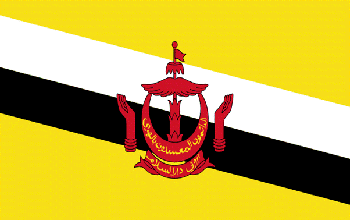 |
Brunei “Brunei Darussalam” (The City of Peace) has an official flag that consists of a yellow base with white and black stripes that run diagonally across the flag. The national emblem in red is superimposed at the center and it includes a swallow-tailed flag on top of a winged column within an upturned crescent above a scroll and flanked by two upraised hands. The crescent on the flag is a symbol of Islam. Below the crescent is a ribbon. The crescent and ribbon have Arabic inscriptions which translate to "State of Brunei, Abode of peace" and "There is no deity but God, Muhammad is the messenger of God".
- Yellow represents the Sultan of Brunei.
- The black and white stripes represent the country’s chief ministers.
|
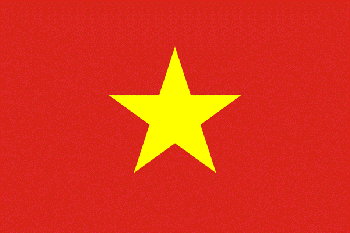 |
Vietnam The Vietnamese flag has a red background with a five-pointed golden-yellow star in the center. Red means the fight for the independence of Vietnam. Yellow is the color of the Vietnamese. The five points of the star stand for the farmers, workers, youth, intellectuals, and soldiers of Vietnam working together in building socialism. The height of this flag is two-thirds the width; the star is two-thirds of the height of the flag. Vietnam's flag was adopted by North Vietnam on November 30, 1955; it was adopted in what had been South Vietnam on July 3, 1976, after the communist North Vietnamese won the civil war and the country was forcefully unified. The red color of the flag also symbolizes revolution and blood. |
| |
|
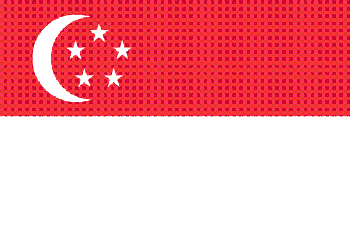 |
Singapore The national flag of Singapore was designed by a committee, headed by Toh Chin Chye (Dr). It consists of two equal horizontal sections, red above white, where the red segment has a white crescent moon beside five stars placed in a circle. The national anthem, Majulah Singapura, the state crest and the national flag were incorporated on 3 December 1959 during National Loyalty Week. The flag replaced the Union Jack which had previously flown over Singapore.
The flag of Singapore consists of two equal horizontal sections, red above white. In the upper left canton is the white crescent moon beside five stars in a circle. The ratio of the width to the length of the flag is two to three.
- Red symbolizes universal brotherhood and equality of man.
- White signifies pervading and everlasting purity and virtue.
- The crescent moon represents a young nation on the ascendant, illuminated by the five ideals as symbolized by the five stars. The five stars represent the ideals of Singapore - democracy, peace, progress, equality and justice.
|
| |
|
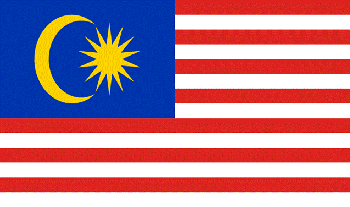 |
Malaysia’s flag is also known as Jalur Gemilang (Malay for "Stripes of Glory"), comprises a field of 14 alternating red and white stripes along the fly and a blue canton bearing a crescent and a 14-point star known as the Bintang Persekutuan (Federal Star).
- The 14 stripes, of equal width, represent the equal status in the federation of the 13 member states and the federal government.
- The 14 points of the star represent the unity between these entities.
- The crescent represents Islam, the country's official religion.
- The blue canton symbolizes the unity of the Malaysian people.
- The yellow of the star and crescent is the royal color of the Malay rulers.
|
| |
|
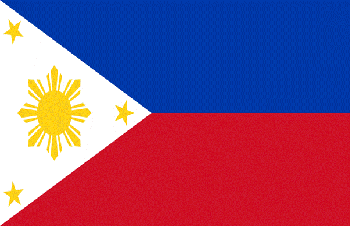 |
The Philippines has a horizontal flag bicolor with equal bands of royal blue and scarlet red, and with a white equilateral triangle at the hoist; in the center of the triangle is a golden yellow sun with eight primary rays, which represent the country's first group of provinces that started the 1896 Philippine Revolution against Spain; and at each vertex of the triangle is a five-pointed golden yellow star, each of which represent the country's 3 main regions - Luzon, Visayas and Mindanao. This flag can indicate a state of war if it is displayed with the red side on top. The flag's length is twice its width, which translates into an aspect ratio of 1:2 but may be smaller. The length of all the sides of the white triangle is equal to the width of the flag. An explanation of the Philippine flag is summarized as follow:
- The blue stands for truth, justice and peace.
- The color red stands for patriotism and valor. The white equilateral triangle stands for equality and fraternity.
- The eight-rayed sun symbolizes the first eight provinces (Manila, Cavite, Batangas, Bulacan, Laguna, Pampanga, Tarlac, Nueva Ecija) that revolted against the Spanish colonial government.
- The three five-pointed stars represent the three main island groups: Luzon, Visayas and Mindanao.
|
| |
|
 |
Indonesia’s flag is commonly known as ”Sang Saka Merah Putih” (The Sacred Red and White) is sometimes referred to as Sang Dwiwarna (The Bicolor). It is based on the banner of the 13th century Majapahit Empire in East Java. The design of the flag is simple with two equal horizontal bands, red (top) and white (bottom) with an overall ratio of 2:3. The two horizontal parts are:
- Red means courage and independence
- White represents the purity of justice
|
| |
|
| |
|
|
|
 |




